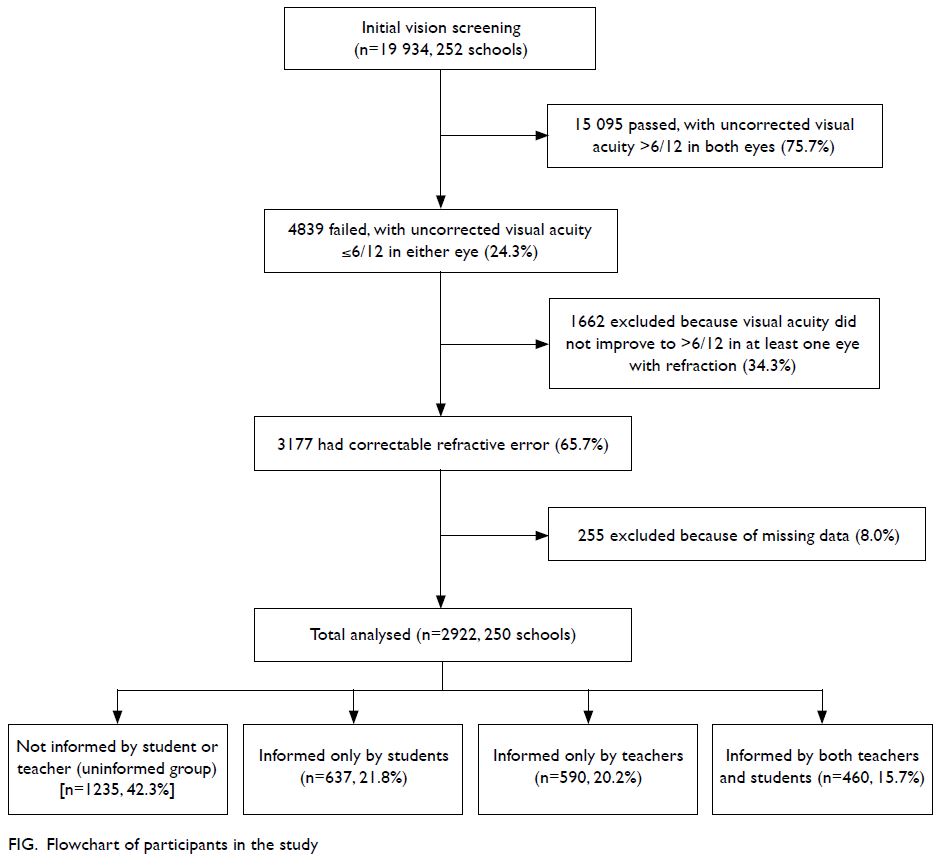Hong Kong Med J 2022 Apr;28(2):152–60 | Epub 25 Mar 2022
© Hong Kong Academy of Medicine. CC BY-NC-ND 4.0
ORIGINAL ARTICLE (HEALTHCARE IN MAINLAND CHINA)
Teacher-to-parent communication and vision
care–seeking behaviour among primary school
students
K Du, PhD Candidate1; J Huang, PhD Candidate2; H Guan, PhD1; J Zhao, PhD1; Y Zhang, PhD Candidate1; Y Shi, PhD1
1 Center for Experimental Economics in Education, Shaanxi Normal University, Xi’an, China
2 College of Economics and Management, China Agricultural University, Beijing, China
Corresponding author: Dr H Guan (guanhongyu2016@163.com)
Abstract
Introduction: To determine the associations
between teacher-to-parent communication and
vision care–seeking behaviour among students.
Methods: This cross-sectional study included
19 934 students from 252 primary schools in
two prefectures in western China. Information
regarding the sampled students was collected
through questionnaires and vision examinations.
Eligible students with uncorrected refractive error
were allocated to four groups according to whether
and how parents were informed about vision
problems in their children: uninformed, informed
by only teachers or only students, or informed by
both. The relationship between teacher-to-parent
communication and vision care–seeking behaviour
was analysed by multiple logistic regression.
Results: Among valid responses (n=2922) analysed,
42.3% (n=1235) of parents were not informed about
vision problems in their children. Teacher-to-parent
communication enabled 35.9% (n=1050) of parents
to learn about vision problems in their children.
When only teachers informed parents, the odds of
students having refraction examinations (odds ratio
[OR]=1.499; P=0.002) and spectacles ownership
(OR=1.755; P=0.002) were significantly higher than
for students in the uninformed group. When both students and teachers informed parents, the odds of
students having refraction examinations (OR=5.565;
P<0.001) and spectacles ownership (OR=7.935;
P<0.001) were highest.
Conclusions: Knowledge of vision problems is an
essential step in vision care for students. Teacherto-
parent communication concerning vision
problems is positively associated with the rate of
vision care–seeking behaviour. Teacher-to-parent
communication provides an important route for
parents to learn about vision problems in their
children.
New knowledge added by this study
- Knowledge of vision problems is an essential step in vision care for students. More than 40% of parents were not informed by students or teachers about vision problems in their children.
- Teacher-to-parent communication is significantly associated with students having refraction examination and spectacles ownership.
- Teacher-to-parent communication provides an important method for parents to learn about vision problems in their children; it also reinforces the effects of students informing their parents.
- Policymakers should carefully consider the role of teachers in vision care for students; teacher-to-parent communication is a cost-effective way to enhance vision care–seeking behaviour among students.
- Teachers should participate in vision care for students, at least in the form of communication with parents.
Introduction
Uncorrected refractive error is the leading cause
of visual impairment among children worldwide; it
affects nearly 13 million children under the age of
16 years, half of whom live in China.1 Uncorrected
refractive error can lead to various broader issues if not treated in a timely manner.2 Uncorrected
refractive error in school-aged children reportedly
has negative effects on academic performance,3
physical and mental health, and quality of life.4
Fortunately, over 80% of refractive error can be
easily and safely corrected by accurately prescribed spectacles.5 However, the correction rate in rural
areas in China is very low.6 A study in 2014 revealed
that in rural China, as few as one in six children
needing spectacles actually wears them.7
The lack of vision problem awareness at the
family level is an important contributing factor in
the low rate of refractive correction in rural areas.8
There are two main ways for parents to learn about
vision problems in their children: from the children
themselves and from their teachers. Information
conveyed by a teacher is more likely to receive
parental attention and cause parents to take action.9
Teacher-to-parent communication (TPC) allows
parents and teachers to exchange information,
strengthen feelings of mutual obligation and trust,
and coordinate efforts to help students thrive in
terms of mental health, school engagement, and
school performance.10 11
However, the relationship between TPC and
vision care–seeking behaviour among students
is not well-investigated, particularly in more
realistic settings. Researchers have indicated that
teachers have an important role in vision care
for students. Chinese rural teachers can perform
vision screening accurately for students with only
moderate training.12 Teachers can help to improve
the uptake of spectacles and the use of spectacles
among students who participate in free spectacles
distribution programmes.13 Considering the
potentially important role of teachers in vision care
for students, further analyses are needed regarding
the interactions between TPC and vision care–seeking behaviour among students.
In this study, our overall goal was to identify
the associations between TPC and vision care–seeking behaviour among students. Specifically,
when teachers informed students’ parents that their
children could not see the blackboard clearly, we
assessed whether the information sharing interacted
with vision care–seeking behaviour among students,
including refraction examinations and spectacles
ownership. To meet this goal, we had three specific
objectives. First, we documented the rates of
vision care–seeking behaviour in four groups,
according to whether and how the parents were
informed about vision problems in their children.
Second, we explored the relationship between
TPC and refraction examination history. Third, we
investigated the association between spectacles
ownership and TPC.
Methods
Setting
The data analysed in this study were collected in two adjacent provinces (Gansu and Shaanxi) of western
China in September 2012. In each of the provinces,
one prefecture that is of the province was chosen for
this study: Tianshui prefecture in Gansu and Yulin
prefecture in Shaanxi. For sample selection, we
obtained a list of all rural primary schools in each
prefecture. We randomly selected 252 townships,
then randomly selected one school per township
for inclusion in the study. Within each school, one
class was randomly chosen in each of the fourth and
fifth grades. This cross-sectional study was approved
by Stanford University (No. ISRCTN03252665,
registration site: http://isrctn.org).
Data collection
The data collected in this study included three parts:
a standardised maths test, questionnaires, and
a vision screening. The standardised maths test
was timed (25 min) and proctored by two study
enumerators at each school. Mathematics testing
was conducted to reduce the effect of home learning
on performance; this facilitated greater focus on
classroom learning.7 We standardised the baseline
maths score, such that the mean score was 0 and the
standard deviation was 1.
Questionnaires were used to collect data from
students, including grade, gender, boarding status,
the main caregivers, parental education, and siblings.
A parental questionnaire asked whether any family
members wore spectacles and whether the parents
thought spectacles were useful. Family wealth was
calculated by summing the values, as reported in
the China Rural Household Survey Yearbook,14 of
the items on the list of 13 durable consumer goods
owned by the family. A parental questionnaire asked
about ownership of 13 selected items as an index of family wealth. The distance from the school to the
county seat was approximated using Google Maps
(Google LLC, Mountain View [CA], United States).
Vision care–seeking behaviour was measured
via self-reporting on the questionnaires administered
to students; it included refraction examination
history (defined as undergoing a refraction
examination in a professional institution before the
day of questionnaire administration) and spectacle
ownership (defined as the possession of spectacles
before the day of questionnaire administration). To
reduce the measurement error, we also asked these
two questions to each student’s parents. Individuals
with inconsistent answers were excluded from the
study.
Teacher-to-parent communication was
measured by asking parents whether they had been
informed by teachers that their children could not
see the blackboard clearly. Students were also asked
whether they had informed their parents about their
vision problems. Based on the responses to these two questions, we allocated all students with vision
problems into four groups: neither teachers nor
students informed parents (uninformed group), only
students informed parents, only teachers informed
parents, and both teachers and students informed
parents (Fig).
Visual acuity assessment and refraction
After completion of the maths test and
questionnaires, a two-part eye examination was
administered to students by a team of qualified
optometrists who followed a prescribed protocol to
ensure standardisation and quality.
First, visual acuity screenings were administered
using Early Treatment Diabetic Retinopathy Study
eye charts, which are regarded as the worldwide
standard for accurate visual acuity measurement.15
Visual acuity values, measured by the Early
Treatment Diabetic Retinopathy Study eye charts,
were transformed into logarithm of the minimum
angle of resolution (logMAR) units; logMAR is one of the most commonly used continuous scales in the
field of ophthalmology/optometry.3 15 Students who
failed the visual acuity screening test (using a visual
acuity cut-off of ≤6/12 in either eye) were enrolled in
a second vision test.
The second vision test was conducted by a
team of one optometrist, one nurse, and one staff
assistant. Children with uncorrected visual acuity
≤6/12 in either eye underwent cycloplegia with up to
3 drops each of cyclopentolate 1% and proparacaine
hydrochloride 0.5%. To ensure that vision problems
among the students could be treated using spectacles,
the students were examined via automated refraction
(Topcon KR 8900; Topcon, Tokyo, Japan) and
subjective refinement by a local optometrist who had
previously been trained by experienced optometrists
from Zhongshan Ophthalmic Center.
Vision problems in the students could be
corrected using spectacles if they met the following
criteria: first, an uncorrected (ie, without spectacles)
visual acuity of ≤6/12 in either eye and refractive
error within the limits associated with significantly
greater improvement in visual acuity upon correction
(myopia ≤-0.75 dioptres, hyperopia >=2.00 dioptres,
or astigmatism [non-spherical refractive error]
>=1.00 dioptres)7; second, visual acuity improvement
to >6/12 in both eyes was possible with spectacles.
Statistical methods
Descriptive statistical analyses were performed
to summarise the demographics of the students
and to compare the proportions of students who
had undergone refraction examination and owned
spectacles among four groups by using the Chi
squared test and one-way analysis of variance.
Refraction examination and spectacle ownership
were both regarded as dummy variables that equalled
one if the corresponding behaviour had occurred
before the study.
Multiple logistic regression was conducted
to ascertain the relationship between TPC and
vision care–seeking behaviour, including refraction
examination history and spectacle ownership. In
all regression analyses, the same covariates were
controlled. Variables included standardised maths
score, grade (grade 5=1), sex (male=1), boarding
status (boarding at school=1), logMAR (continuous
scale of visual acuity), whether parents are the
main caregivers (yes=1), parental education for
both mother and father (completed >=12 years of
education=1), siblings (at least one sibling=1),
whether any family members wear spectacles
(yes=1), whether parents think spectacles are useful
(yes=1), family wealth, and distance from school to
the county seat. A P value of <0.05 was regarded as
a statistically significant difference. All analyses were
performed using Stata 14.1 (Stata Corp, College
Station [TX], United States).
Results
Among 19 934 students in 252 schools, 4839 (24.3%)
students failed the vision screening. In total, 3177
(65.7%) students in 250 schools were eligible for
spectacles to improve visual acuity (two schools
were excluded because no students at either school
met the inclusion criteria). After the exclusion of
students with missing information, the remaining
2922 students were divided into four subgroups.
In our study, 42.3% (n=1235) of parents were not
informed by either their children or their children’s
teachers. Teacher-to-parent communication
enabled 35.9% (n=1050) of parents to learn about
vision problems in their children. In total, 20.2%
(n=590) parents were informed only by teachers and
15.7% (n=460) were informed by both teachers and
students, respectively (Fig).
The mean (± standard deviation) age of all
students with vision problems was 10.51 ± 1.10 years
(range, 8-15). Among all respondents, 1418 (48.5%)
were boys and 1504 (51.5%) were girls. Most students’
main caregivers were their parents (86.4%). Other
participants’ characteristics are shown in Table 1,
including the comparison of characteristics among
the four groups.
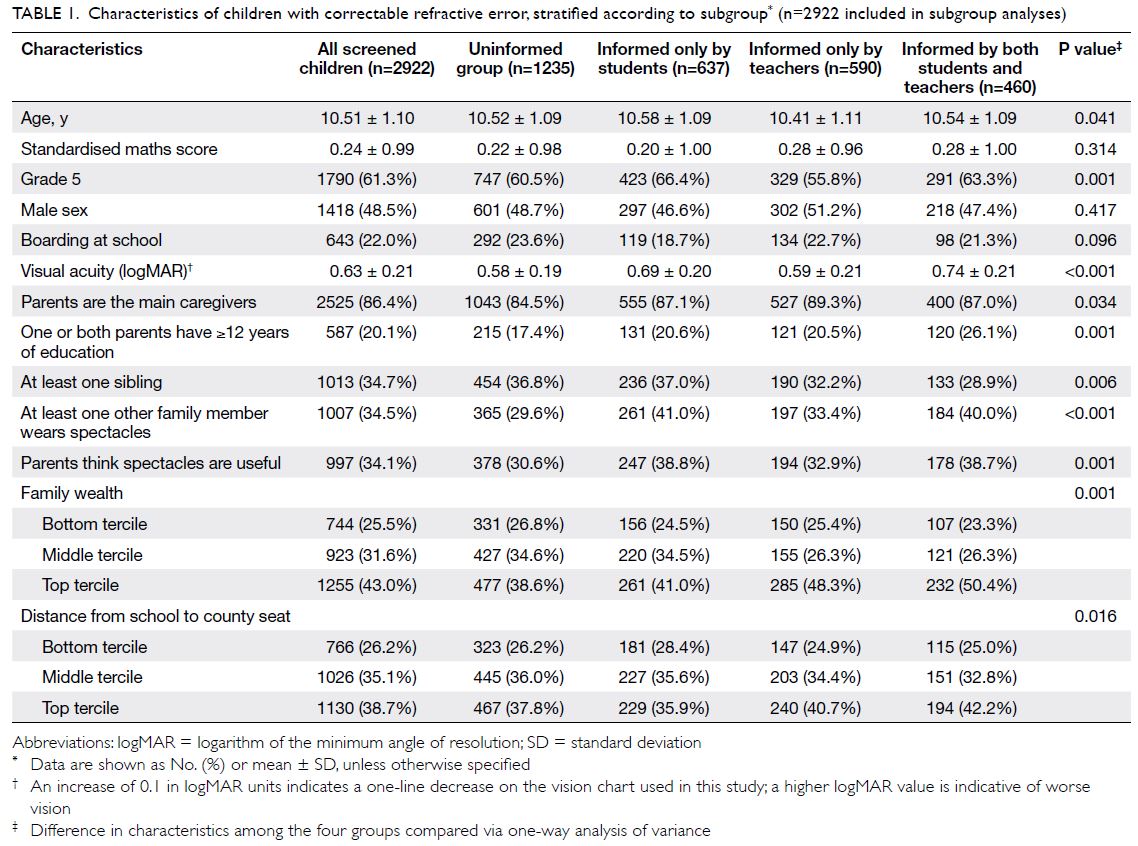
Table 1. Characteristics of children with correctable refractive error, stratified according to subgroup* (n=2922 included in subgroup analyses)
The rate of vision care–seeking behaviour
among all students was very low. The number of
students who received vision care services decreased
gradually at each step. In all, 57.7% (n=1687) of
parents were informed about vision problems in
their children; only 32.7% (n=954) of all parents took
their children for refraction examinations. Finally,
only 19.2% (n=560) of students owned spectacles
before the study (Table 2). The rates of vision care–seeking behaviour significantly differed among the
four groups. When comparing the rates of refraction
examination history and spectacle ownership among
three types of informed groups with the uninformed
group, we found significant differences (P<0.001) in
all comparisons (Table 2). In the uninformed group,
comparatively few parents took their children to
receive a refraction examination and/or obtained
spectacles for their children. In the group where
parents were informed only by students, more
children had undergone refraction examinations
and/or owned spectacles than in the group where
parents were informed only by teachers. When both
teachers and students informed parents, the rates of
refraction examinations and spectacles ownership
were highest among the four groups.
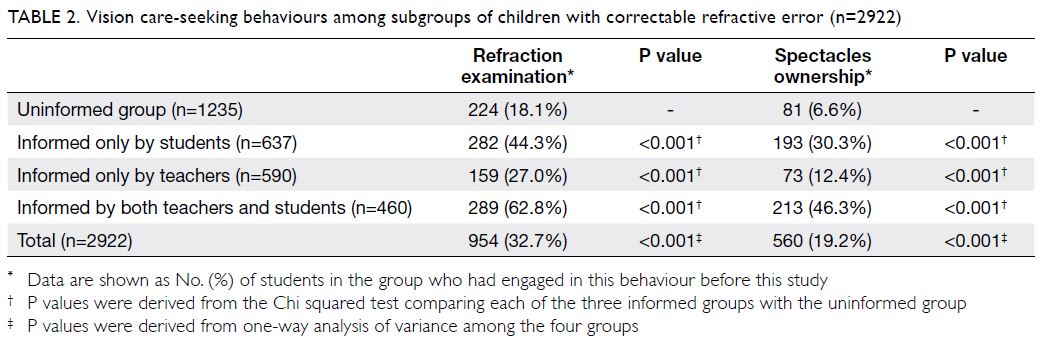
Table 2. Vision care-seeking behaviours among subgroups of children with correctable refractive error (n=2922)
In the multiple logistic regression analyses of
potential predictors of refraction examination, we
found that information sharing (including TPC) was
significantly associated with refraction examination
history (Table 3). Compared with the uninformed
group, the odds of students having a refraction
examination was higher in each of the other three
groups. When only teachers informed parents, the odds ratio (OR) was 1.499, which was lower than
in the group where only students informed parents
(OR=2.839). When both students and teachers
informed parents, the odds of students having a
refraction examination was highest (OR=5.565). Additionally, the following characteristics were significantly positively
associated with refraction examination history:
receiving a better maths score (P=0.031), being male
(P=0.015), having a worse visual ability (P<0.001),
having at least one other family member who wears
spectacles (P<0.001), being in the top wealth
tercile (P<0.018), and having parents who think that spectacles are useful (P<0.001) [Table 3].
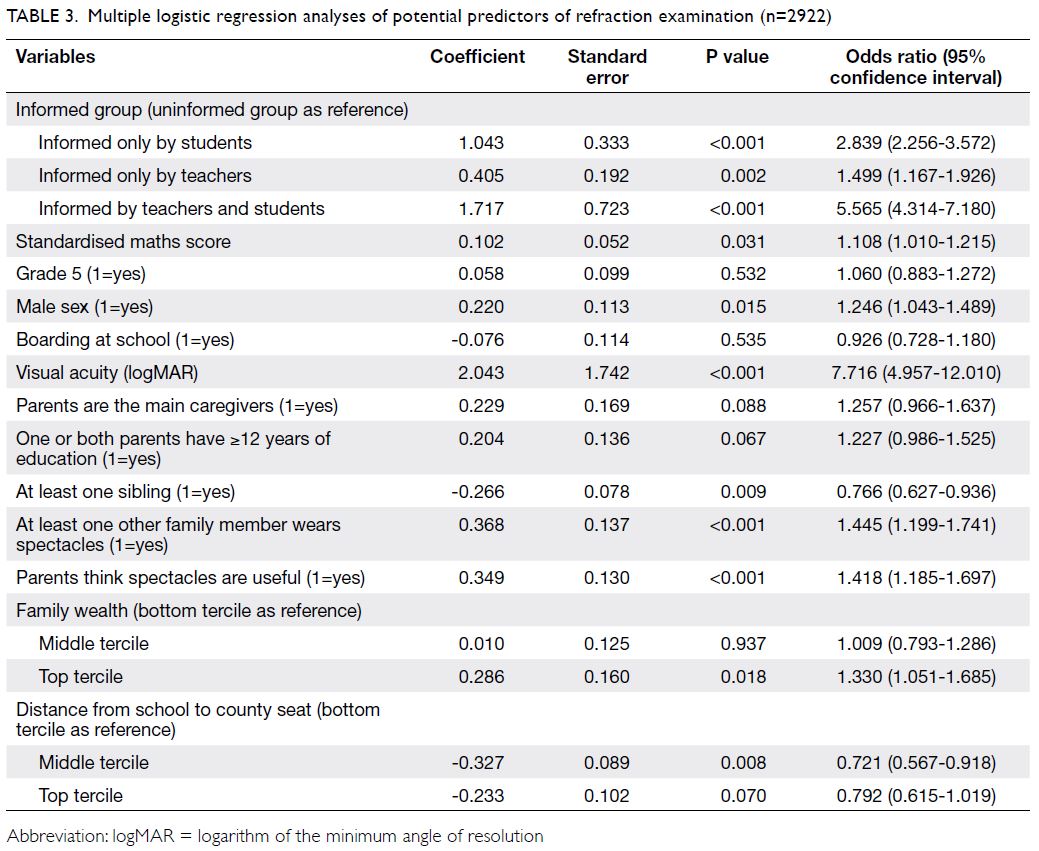
Table 3. Multiple logistic regression analyses of potential predictors of refraction examination (n=2922)
Multiple logistic regression analyses were
used to estimate the relationship between TPC
and spectacles ownership (Table 4). Teacher-to-parent
communication was significantly positively
associated with spectacles ownership, regardless of
whether students informed parents about their vision
problems. The odds of students having spectacles
ownership in the group where parents were informed
by both teachers and students (OR=7.935) was
almost 1.8 times that in the group where parents were
informed only by students (OR=4.413). The odds of
students having spectacles ownership in the group
where parents were informed by students only was
twice that in the group where parents were informed
only by teachers (OR=1.755). Furthermore, the
following characteristics were significantly positively
associated with spectacles ownership: having worse
visual acuity (P<0.001), having parents as the main
caregivers (P<0.017), having at least one other family
member who wears spectacles (P<0.001), and having
parents who think spectacles are useful (P<0.001).
Notably, students with at least one sibling (P=0.003)
were more unlikely to purchase spectacles (Table 4).
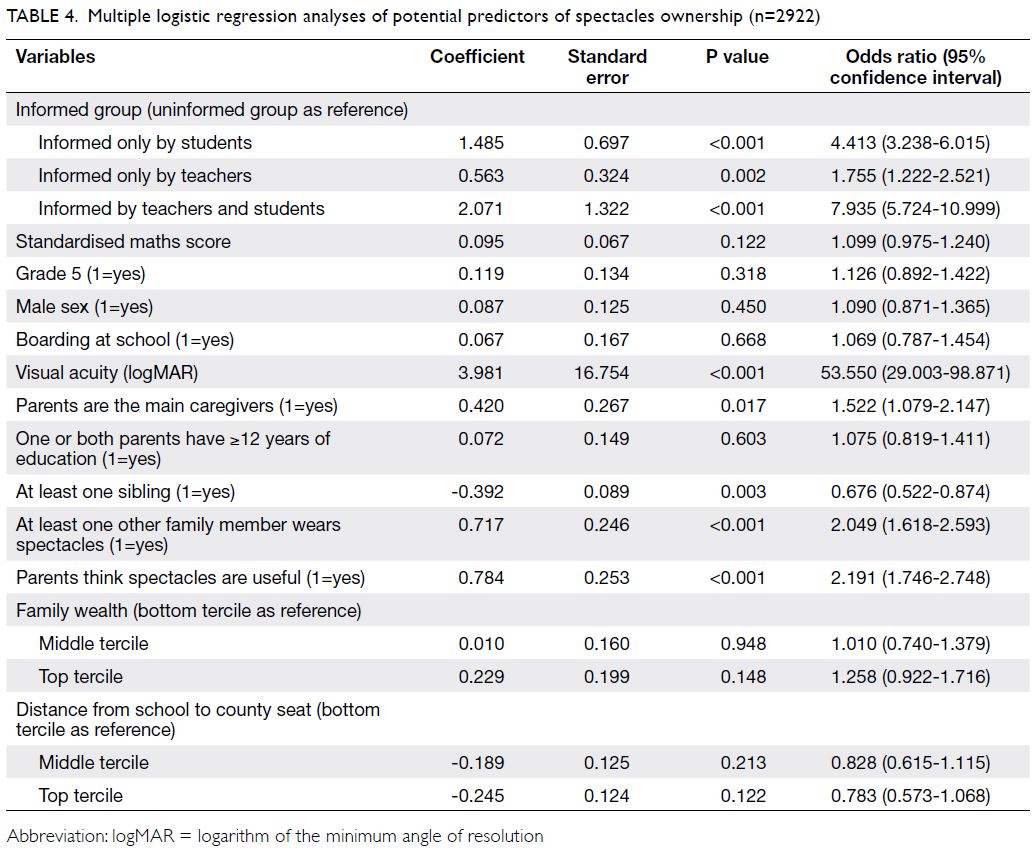
Table 4. Multiple logistic regression analyses of potential predictors of spectacles ownership (n=2922)
Discussion
Factors affecting vision care–seeking
behaviour
In this study, we found that the rate of vision care–seeking behaviour was very low in our sample area,
similar to previous results.16 17 There are two possible
reasons for the low vision care–seeking behaviour
rate. First, parents may not know that their children
cannot see the blackboard clearly; thus, they will
not actively seek vision care services. Second, the
number of students receiving vision care services
has been decreasing throughout the process of three
stages: parental knowledge that their children have
vision problems, parental action to ensure their
children undergo refraction examinations, and
parental acquisition of spectacles for their children.
Furthermore, despite sufficient information, many
parents do not seek vision care services because of
misinformation or misunderstanding.18 19
Knowledge of vision problems is the initial
aspect of the vision care–seeking process for
students. The rates of refraction examination history
(18.1%) and spectacles ownership (6.6%) were the lowest in the uninformed group, which comprised
more than 40% of parents in this study. When
parents were informed by students and/or teachers,
the rate of vision care–seeking behaviour was much
higher. Teacher-to-parent communication provides
an important method for parents to learn about
vision problems in their children. In this study,
20.2% of parents learned about their children’s vision
problems only from teachers.
Effects of teacher-to-parent communication
on vision care–seeking behaviour
Although a considerable proportion of students did
not receive vision care in the care-seeking process,
TPC can reduce this to some extent. When both
teachers and students informed parents, the rate
of spectacles ownership was the highest. In the group that parents were
informed by both teachers and students, 46% of
students finally received spectacles, which is 7-times
more students than in the group in which parents
were not informed. Furthermore, the odds of students
having refraction examination and spectacles
ownership were higher in the group where parents
were informed only by students than in the group where parents were informed only by teachers. These
additional opportunities may increase the likelihood
that parents act to correct those vision problems.
There are two possible explanations for the
positive association between TPC and vision care–seeking behaviours among students in this study.
Teacher-to-parent communication provides an
important channel for parents to learn about the
vision problems in their children, which is a starting
point and key aspect of vision care for students.
Second, TPC reinforces the effects of students
informing their parents. Compared with the group
where parents were informed only by students,
the rates of refraction examinations and spectacles
ownership were nearly twofold greater in the group
where parents were informed by both students and
teachers. This was presumably because parents
learned about vision problems in their children from
two sources; the information from the students was
reinforced by the information from the teacher.20
Implications of promoting teacher-to-parent
communication
Small efforts by teachers may have great benefits in terms of vision care for students. Compared with intervention programmes to increase the
correction rate,7 21 the results of present study
indicate that TPC is both easy and cost-effective.
Teachers should inform parents that their children
cannot see the blackboard clearly. Studies of free
spectacles distribution programmes have also shown
that teachers can improve spectacles usage rates
among students who have received spectacles.13 22
Moreover, wearing spectacles can improve academic
performance,7 21 implying that TPC may both
increase the correction rate and have a positive role
in academic performance. Therefore, policymakers
should carefully consider the role of teachers in
protecting vision among students. Indeed, the
Chinese Government has noted that multilateral
cooperation (involving teachers, schools, parents,
and society in general) should be encouraged to
protect vision among students, in an effort to improve
health status among young people by 2020.23
Unfortunately, the TPC ratio is very low. A
recent study in China noted that approximately half
of the parents and teachers communicate, in any
form, during the course of an entire school year.24
In our study, the proportion of parents who were
informed by teachers was only approximately 36%,
including parents informed only by teachers (20%)
and parents informed by both teachers and students
(16%). This is presumably because teachers do not
know a particular student’s vision status because it
is not a vital consideration for most education work.
Vision screening is the best method to detect vision
problems.25 The education bureau and the health
bureau should conduct routine vision screenings
and encourage teachers to engage in vision
protection (eg, communicate with parents about
vision problems in students).5 25 If those stakeholders
began to take action, more parents will learn about
vision problems in their children and seek vision
care services.
Effects of students’ informing on vision care–seeking behaviour
In the present study, the effects of students
informing parents were greater than the effects of
teachers informing parents when only one party
informs the parents of vision problems. This finding
implies that parents were more likely to act when
they received information from students. However,
students are often unaware of vision problems. Thus,
teachers have an important effect; a previous survey
reported that teachers were most likely to perceive
visual impairment in children (70.6%), followed by
the children’s parents (18.9%) and by the children
themselves (7.9%).26 Therefore, careful attention is
needed concerning the role of teachers in identifying
vision problems, encouraging communication
between students and their parents about such
problems.
Limitations
There were three important limitations in this
study. First, the study could not investigate any
causal link between TPC and vision care–seeking
behaviour because of the cross-sectional design.
However, the findings provide a foundation for
follow-up analyses of causality. Second, this study
only focused on whether teachers informed parents
about vision problems in their children; it did not
collect information concerning how parents were
informed. Teacher-to-parent communication may
happen in many ways, particularly in the internet
era (eg, teachers communicate with parents via
instant messenger). Additional research is needed to
determine the types of TPC that are most effective
in vision care for students. Third, the participants
in this study were recruited from two provinces in
rural north-western China, which limits the external
validity of the findings. Despite this limitation,
in the context of widespread uncorrected vision
impairment among students,27 our study still has
important implications for improving the uptake
rate of vision care services.
Conclusions
Teacher-to-parent communication can significantly
enhance the rates of refractive examinations and
spectacles uptake through direct and indirect ways.
Not only teacher informing provides a new channel
for parents to learn about their students’ vision
problems, but also reinforce the information told
by students. Teacher-to-parent communication is
an easy and cost-effective way to improve the rate
of vision care–seeking behaviour. Policymakers
should encourage teachers to be more involved
in students’ vision protection, such as motivating
teachers to communicate timely with parents about
the students’ vision status.
Author contributions
Concept or design: K Du, J Huang.
Acquisition of data: H Guan, Y Shi.
Analysis or interpretation of data: All authors.
Drafting of the manuscript: K Du.
Critical revision of the manuscript for important intellectual content: All authors.
Acquisition of data: H Guan, Y Shi.
Analysis or interpretation of data: All authors.
Drafting of the manuscript: K Du.
Critical revision of the manuscript for important intellectual content: All authors.
All authors had full access to the data, contributed to the study, approved the final version for publication, and take responsibility for its accuracy and integrity.
Conflicts of interest
All authors have no conflicts of interest to disclose.
Funding/support
This research was supported by the 111 Project (Ref: B16031).
H Guan has received funding from the National Natural
Science Foundation of China (Ref: 71803107). The funders
had no role in the design of the study, the acquisition or
interpretation of results, or the decision to submit the
manuscript for publication.
Ethics approval
This study was approved by Stanford University (No.
ISRCTN03252665). Permission was received from local
boards of education in each region and the principals of all
schools. The presented data are anonymised, and the risk
of identification is low. The principles of the Declaration of
Helsinki were followed throughout.
References
1. Jonas JB, Xu L, Wei WB, et al. Myopia in China: a population-based cross-sectional, histological, and
experimental study. The Lancet 2016;388:S20. Crossref
2. Smith TS, Frick KD, Holden BA, Fricke TR, Naidoo KS. Potential lost productivity resulting from the global burden
of uncorrected refractive error. Bull World Health Organ
2009;87:431-7. Crossref
3. Yi H, Zhang L, Ma X, et al. Poor vision among China’s rural primary school students: Prevalence, correlates and consequences. China Econ Rev 2015;33:247-62. Crossref
4. Chadha RK, Subramanian A. The effect of visual impairment on quality of life of children aged 3-16 years.
Br J Ophthalmol 2011;95:642-5. Crossref
5. World Health Organization. Sight test and glasses could dramatically improve the lives of 150 million people with
poor vision. 2006; Available from: http://www.who.int/mediacentre/news/releases/2006/pr55/en/. Accessed 9 Jan
2018.
6. He M, Xu J, Yin Q, Ellwein LB. Need and challenges of refractive correction in urban Chinese school children.
Optom Vis Sci 2005;82:229-34. Crossref
7. Ma X, Zhou Z, Yi H, et al. Effect of providing free glasses on children’s educational outcomes in China: cluster randomized controlled trial. BMJ 2014;349:g5740. Crossref
8. Resnikoff S, Pasolini D, Mariotti SP, Pokharel GP. Global magnitude of visual impairment caused by uncorrected
refractive errors in 2004. Bull World Health Organ 2008;86:63-70. Crossref
9. Adams KS, Christenson SL. Trust and the family–school relationship examination of parent–teacher differences
in elementary and secondary grades. J Sch Psychol
2000;38:477-97. Crossref
10. Franklin CG, Kim JS, Ryan TN, Kelly MS, Montgomery KL. Teacher involvement in school mental health interventions: A systematic review. Child Youth Serv Rev 2012;34:973-82. Crossref
11. Kraft M, Dougherty SM. The effect of teacher-family communication on student engagement: evidence from a
randomized field experiment. J Res Educ Eff 2013;6:199-222. Crossref
12. Sharma A, Li L, Song Y, et al. Strategies to improve the accuracy of vision measurement by teachers in rural Chinese secondary schoolchildren: Xichang pediatric
refractive error study (X-PRES) report no. 6. Arch
Ophthalmol 2008;126:1434-40. Crossref
13. Yi H, Zhang H, Ma X, et al. Impact of free glasses and a teacher incentive on children’s use of eyeglasses: a cluster-randomized controlled trial. Am J Ophthalmol
2015;160:889-96.e1. Crossref
14. China National Bureau of Statistics. China Statistical Yearbook. Beijing, China: China State Statistical Press;
2013.
15. Camparini M, Cassinari P, Ferrigno L, Macaluso C. ETDRS-Fast: implementing psychophysical adaptive
methods to standardized visual acuity measurement with
ETDRS charts. Invest Ophthalmol Vis Sci 2001;42:1226-31.
16. Qian DJ, Zhong H, Nie Q, Li J, Yuan Y, Pan CW. Spectacles need and ownership among multiethnic students in rural
China. Public Health 2018;157:86-93. Crossref
17. Zhao J, Guan H, Du K, et al. Visual impairment and spectacles ownership among upper secondary school
students in northwestern China. Hong Kong Med J
2020;26:35-43. Crossref
18. Dudovitz RN, Izadpanah N, Chung PJ, Slusser W. Parent, teacher, and student perspectives on how corrective lenses improve child wellbeing and school function. Matern Child
Health J 2016;20:974-83. Crossref
19. Senthilkumar D, Balasubramaniam SM, Kumaran SE, Ramani KK. Parents’ awareness and perception of children’s eye diseases in Chennai, India. Optom Vis Sci
2013;90:1462-6. Crossref
20. Verhulst FC, Dekker MC, van der Ende J. Parent, teacher and self-reports as predictors of signs of disturbance in
adolescents: whose information carries the most weight?
Acta Psychiatr Scand 1997;96:75-81. Crossref
21. Ma Y, Congdon N, Shi Y, et al. Effect of a local vision care center on eyeglasses use and school performance in
rural China: a cluster randomized clinical trial. JAMA
Ophthalmol 2018;136:731-7. Crossref
22. Wang X, Ma Y, Hu M, et al. Teachers’ influence on purchase
and wear of children’s glasses in rural China: The PRICE
study. Clin Exp Ophthalmol 2019;47:179-86. Crossref
23. Ministry of Education, PRC Government. Ministry
of education on implement plan for comprehensive
prevention and control of myopia among children and
adolescents. Available from: http://www.moe.gov.cn/srcsite/A17/moe_943/s3285/201808/t20180830_346672.html. Accessed 9 Jan 2020.
24. Li G, Lin M, Liu C, Johnson A, Li Y, Loyalka P. The prevalence of parent-teacher interaction in developing
countries and its effect on student outcomes. Teach Teach
Educ 2019;86:102878. Crossref
25. Glewwe P, Park A, Meng Z. A better vision for development: eyeglasses and academic performance in rural primary
schools in China. J Dev Econ 2016;122:170-82. Crossref
26. Alves MR, Temporini ER, Kara-José N. Ophthalmological
evaluation of schoolchildren of the public educational
system of the city of São Paulo, Brazil: medical and social
aspects [in Portuguese]. Arq Bras Oftalmol 2000;63:359-63. Crossref
27. Ma Y, Zhang X, He F, et al. Visual impairment in rural and migrant Chinese school-going children: prevalence,
severity, correction and associations. Br J Ophthal
2022;106:275-80. Crossref


